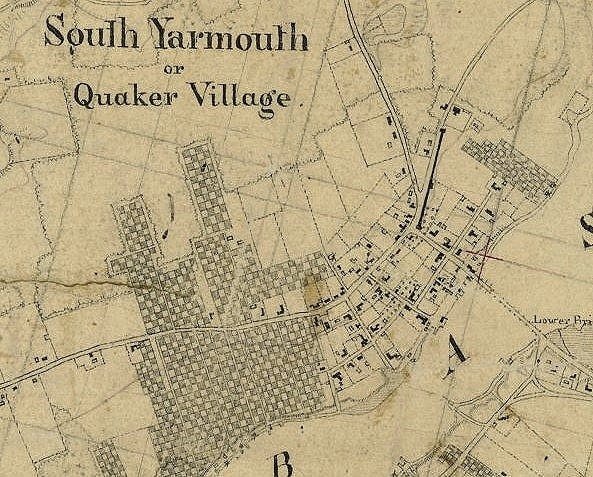The saltworks industry in Yarmouth, which prevailed for one hundred years, began at Bass River in 1809. Its roots, cultivated by Capt. John Sears and Hattil Killey, were in the East Precinct of Yarmouth, which became Dennis in 1793. The first surviving salt manufacturing deed, dated 1811, references Seth and Zeno Killey, Abiel Akin, and Isaiah Crowell’s existing saltworks along Bass River. Seth Killey’s business journal records salt stocks in 1810.
Saltworks (denoted by the checkerboard pattern) along Bass River.
In Friends Village, saltworks were built continuously from Wing Street to 175 Old Main Street and along Bass River. Significant saltworks were built west of Old Main Street, some nearly three quarters of the way to Long Pond. Almost all of the salt manufacturing in this area was owned by members of the Society of Friends.
The Yarmouth Friends (Quakers), who were a self-contained community, took care of their sick, their poor, and their legal issues. Believing in equal opportunities for all, the women conducted their own business meetings as early as 1681.
Under normal conditions at this time, when a man died, his estate was distributed according to his will. Usually, the wife would receive one third of his estate; however, there were six women living in Friends Village, all members of the Society of Friends, who became owners of salt manufacturing businesses after their husbands or fathers died. These women were: Rebecca Frye, Tamsen Gifford, Tamsen Freeman (Gifford) Baker, Rebecca (Wing) Steere, Rhoda (Gifford) Wing, and Eliza Wood. The following is a testament to their business acumen.
Rebecca Frye was the daughter of Thomas Akin who owned saltworks in Friends Village until his sudden death in 1841. In the distribution of his estate in 1844, David Kelley was entrusted to manage fourteen hundred feet of saltworks for Akin’s two minor children, Rebecca and Abiel. Rebecca managed her portion of the works for six years and in 1853, at twenty-seven years old, Rebecca sold her share of the works to her uncle David K. Akin.
Tamsen Freeman (Gifford) Baker was the daughter of Prince Gifford who was a large salt manufacturer in Friends Village. The family lived on Union Street where the parking lot of the Cultural Center is today. Gifford owned multiple strings of saltworks that ran behind the row of residences along Old Main Street from Mill Lane to Saltworks Lane. One mill and a salt house was built at Bass River. Prince Gifford died in 1844, leaving his saltworks to his daughter Tamsen Freeman (Gifford) Baker. Under his daughter Tamsen’s ownership, the valuation of these works listed on the 1850 and 1860 census was two thousand dollars. She ran these works for seventeen years and in 1861 sold all the works to her mother Tamsen Gifford. Under Tamsen Gifford’s ownership, the 1870 census listed the valuation of her estate at twenty-five hundred dollars. In 1883, Tamsen deeded back to her daughter Tamsen F. Baker half the works. In 1885, she deeded the other half to her son Prince.
Robert Wing was an extensive salt manufacturer whose business, Robert Wing & Company, was mainly in Bass River Village. In 1807, he married Elizabeth Killey, and lived on the corner of Union and Old Main Streets. They had one surviving child named Rebecca. Wing later married Abigail Smith. His daughter, Rebecca married Thomas Ellwood Steere of Providence, RI. Wing’s saltworks were valued on the 1850 census at seven thousand dollars. He died in 1856, leaving all of his saltworks to his wife Abigail and daughter Rebecca Steere.
In 1860, Abigail Wing and Rebecca Steere sold over seven thousand feet of saltworks in Bass River Village to David Smith, Barnabas Sears Jr., Isaiah Crocker, and her first cousin David Kelley. Abigail left South Yarmouth to live the rest of her life in New Bedford among family. Rebecca Steere managed these saltworks at Bass River Village between the County Road and Bass River for thirty years. In 1885, she sold the remaining five thousand feet of works to David Kelley. These works were active until 1889 and were the last saltworks remaining in Bass River Village.
Rhoda (Gifford) Wing was the daughter of Prince Gifford and wife of Daniel Wing Sr. They lived at 6 Akin Street right behind the Gifford homestead. In 1841 Daniel Wing Sr. bought the works from Abraham Shearman Jr. and Isaiah Crowell northwest of the County Road. Wing died suddenly in 1842 and the works then were managed by his wife Rhoda. The value of these works listed on the 1850 and 1860 census was two thousand dollars. Rhoda is identified as a Merchant on the 1860 census. After managing the works for twenty-eight years, the heirs sold the works northwest of the County Road to Daniel Wing Jr. In 1872, the heirs sold the works adjoining Crosby Street to Capt. George Crocker. These were some of the last saltworks to be operable in Friends Village.
Eliza (Baker) Wood was the wife of Saltmaker Francis Wood. Their works were bought from Zeno Killey in 1849 and 1850. The land acquired in 1850, contained two and one quarter acres of saltworks, located on the south side of Homer Avenue between the County Road and Bass River. Francis died in 1853 leaving the works to his wife Eliza. She managed these works, referred to as “Aunt Eliza’s Saltworks”, for eighteen years until 1871 when she and her daughter deeded all this property to Isaiah Crocker.
These six remarkable women, with their savvy business-sense and steadfast determination, secured a lasting legacy in Yarmouth’s historic saltworks industry.
Researched and written by Robert Kelley.
To learn more about South Yarmouth’s saltworks, be sure to visit the Cultural Center of Cape Cod during March 2024 for the exhibit Lost History reDiscovered.







